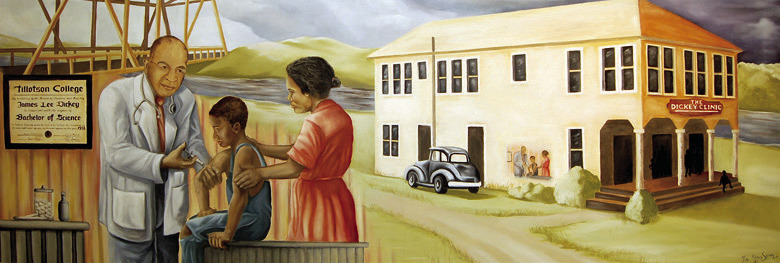JUNETEENTH
The legacy of Dr. James Lee Dickey
TAYLOR –– As residents celebrate Juneteenth this month, a local museum continues to uphold the memory of the late James Lee Dickey, an early 20th-century African American physician and civil rights pioneer.
Dickey gained worldwide fame for transforming the racial landscape of Taylor during segregation, and those honoring his legacy today say even losing the family home in 2022 to arson — a pivotal piece of the museum’s future — will not deter them.
“Dr. Dickey was more than just a doctor,” said Nakevia Miller, a board member of the Dickey Museum & Multipurpose Center, which seeks to memorialize the life of Dickey, who established a modern hospital in Taylor for Blacks during the 1930s, among other accomplishments.
“He was an advocate. He was an activist, and one of the things he did was making sure people had not just jobs and a roof over their heads, but they had places for respite and opportunities to relax and be in (the) community,” Miller added.
“The name Dr. Dickey makes me think of family, and of generations,” said lifelong Taylor resident Teri Williams, a community health worker the museum recently hired to promote wellness resources in District 1 and other areas of Taylor.
“My family is a product of Dr. Dickey,” Williams added. “My mom, my aunt and my uncle were all delivered by Dr. Dickey.
There has never been a time growing up here in Taylor when I haven’t heard his name mentioned. I even lived on Dickey Street a block up from where his original location was…Knowing I’m now in that role to continue the work that he started well before my time, it blows my mind… I tear up sometimes.”
Dickey was born Nov. 12, 1893, in Waco, the second of 10 siblings, to John Strait Dickey and Linnie Alberta Dickey.
From an early age, Dickey excelled academically and was the valedictorian of his class at A.J. Moore High School in Waco in 1912. He graduated with honors from Tillotson College in Austin, now known as Huston-Tillotson College, with a Bachelor of Arts degree in 1916.
Soon after, Dickey enrolled in Meharry Medical College in Nashville, Tennessee,
“He (Dr. James Lee
Dickey) wasn’t in it for the money. He was in it to help people.”
— James Dickey Jr., son graduating with a medical degree in 1921. That same year, Dickey reportedly made a trip to Taylor to visit a friend, but he soon learned there were no Black doctors in the area and decided to settle there with his new bride, Magnolia P. Dickey.

“When he graduated, he came back to Taylor because he wanted to help his mom in Waco,” said James Dickey Jr., 88, his only son who now lives in Austin. “When he got there, he felt that God put him there… He saw people there who needed him, Hispanic and African American people. He wanted to help them—and he did.”
COMPASSIONATE CARE
Prior to Dickey’s arrival, African Americans in Taylor reportedly often received second-class treatment from White doctors in an outbuilding behind the city’s hospital.
“At the time that he became a doctor, he was one out of only 130 African American doctors in Texas by itself,” said Ben Geiger, the curator at The Williamson Museum in Georgetown. “His was the only medical facility for Blacks in Williamson County, so people were having to travel to him to get medical care.”
According to Dickey’s obituary published after his death May 18, 1959, during a typhoid epidemic in 1932, Dickey launched a vaccination campaign; partnered with area churches, schools and clubs to teach people how it was spread; and convinced city leaders to open up public hydrants in different areas of the city to prevent poor residents from having to get their water from Bull Ranch Creek.
“He actually slowed down a typhoid fever outbreak in the area through a very rigorous vaccination program,” Geiger said. “He slowed down the epidemic.”
In 1935, according to reports, Dickey debuted a modern, 15-bed hospital at 401 Bland St., where he set up a prenatal clinic, and worked to treat venereal disease, among many other health initiatives.
“He wasn’t in it for the money,” his son recalled. “He was in it to help people … People would come down and weren’t able to pay him; he would tell them, ‘That’s all right.’ They would give him different things, but it wasn’t money. They would bring him some food or something like that.”
In addition, in 1935, James Lee Dickey established the Black Chamber of Commerce, and with his wife, the Welfare Workers Club. Through their efforts, the Dickeys helped secure new school and recreational facilities, a federal housing project and more for the African American community in Taylor.
In 1953, in an event that made headlines around the country, Dickey received the Outstanding Man of the Year for 1952 at the annual Chamber of Commerce banquet by all-White leaders of the city.
“This is an honor which I had never hoped to receive, one for which I am very grateful,” Dickey said in his acceptance speech. “Here I am surrounded by all of you dignitaries. When I look out at the audience, I see the cream of Taylor, the rulers of this town and this community, and … I was thinking it would be a fine thing if some of you could be members of the (Black) Chamber of Commerce.”
Dickey’s son said he remembers going out to the segregated country club with his father to accept the award.
“I went out there with him,” Dickey said. “He knew he couldn’t say too much, and yet he could say what he wanted to say because he had his business of helping people… They respected him.”
That a Black doctor in a small Texas town could receive such an honor during the height of segregation garnered widespread press coverage.
“It made news and conversation all over the nation,” wrote George Sessions Perry in the Oct. 23, 1953, issue of the Saturday Evening Post, the most widely read magazine of the time. “So far as anyone seemed to know, such a thing had never happened before in the United States.”
Dr. Dickey’s unprecedented honor was soon followed by many other awards, including alumnus of the year for Tillotson, as well as the Lone Star State Medical Association’s General Practitioner Awards.
Though James Dickey Jr. remembers his father as someone who worked long hours, Don Hill, a close friend of the Dickey family and the first Black mayor of Taylor, also remembers the doctor’s playful side.
“On Friday nights when there were no TVs in the homes, Dr. Dickey had one,” said Hill, 87. “So a group of boys would go to his house in the game room there and watch TV. When Dr. Dickey would come home at night, he would get right in the middle of the boys. We would be on the floor watching TV, and he would just get right in the middle…He always made us feel at ease.”
DICKEY MUSEUM’S FUTURE
Following a fire in June 2022, the Historic Dickey Museum & Multipurpose Center has been without a physical location, but leaders are working to change that through a $500,000 grant from the St. David’s Foundation.
The 2023 grant is designed to help rebuild a replica of the Dickey family home, which was listed on the National Register of Historic Places.
Three years ago, the building, located at 500 Burkett St, was destroyed by arson on the eve of opening.
Though an arrest was made, a Williamson County grand jury declined to issue an indictment due to a lack of evidence.
James Dickey Jr. said the fire brought back memories of racial injustice.
“Building this museum took a long time,” Dickey said. “It puts a bad taste in my mouth.”
In the meantime, museum officials say they are undeterred from continuing the work Dr. Dickey began.
For the past decade, the Dickey Museum had hosted a number of cultural events and educational opportunities, including “Dickey Day,” an annual health and resource fair; an anti-truancy program at Taylor High School; healthy cooking classes in conjunction with the Sustainable Food Center; and more.
“My commitment and connection to his legacy is on the side of good troublemaking and being a quality-oflife innovator,” Miller said. “That is more than him just being a local doctor, and local doctors were very important to the community, especially whole communities of color. He was a very important figure and we have some very big shoes to fill.”
Williams said just as Dickey was tenacious about fixing problems, officials will move forward with rebuilding the family home turned museum.
“To have the arson happen, it’s just a stumbling block, so we can only go up from here,” Williams said. “It’s a rebirth. It’s like the phoenix coming out of the ashes. It’s only going to make us stronger. It’s going to show that even during hard times, we can still persevere and come out on top.”
For more, visit dickeymuseum.org/.



Comment
Comments